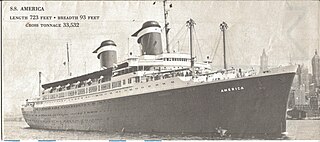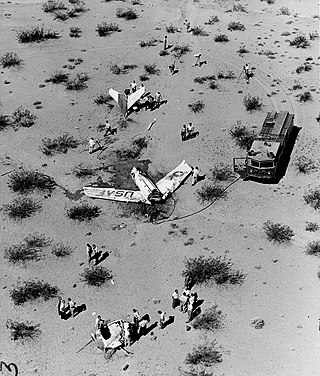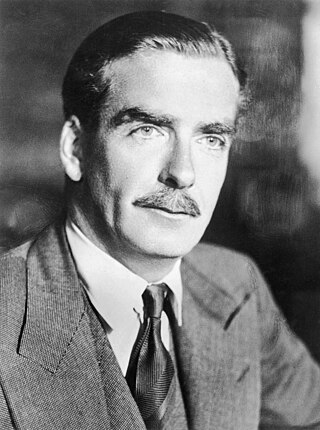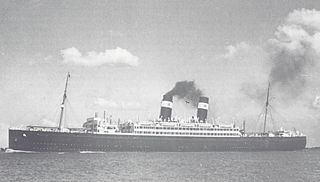Related Research Articles

The Suez Canal is an artificial sea-level waterway in Egypt, connecting the Mediterranean Sea to the Red Sea through the Isthmus of Suez and dividing Africa and Asia. The 193.30-kilometre-long (120.11 mi) canal is a key trade route between Europe and Asia.

1956 (MCMLVI) was a leap year starting on Sunday of the Gregorian calendar, the 1956th year of the Common Era (CE) and Anno Domini (AD) designations, the 956th year of the 2nd millennium, the 56th year of the 20th century, and the 7th year of the 1950s decade.

The Suez Crisis also known as the Second Arab–Israeli War, the Tripartite Aggression in the Arab world and as the Sinai War in Israel, was a British–French–Israeli invasion of Egypt in 1956. Israel invaded on 29 October, having done so with the primary objective of re-opening the Straits of Tiran and the Gulf of Aqaba as the recent tightening of the eight-year-long Egyptian blockade further prevented Israeli passage. After issuing a joint ultimatum for a ceasefire, the United Kingdom and France joined the Israelis on 5 November, seeking to depose Egyptian president Gamal Abdel Nasser and regain control of the Suez Canal, which Nasser had earlier nationalised by transferring administrative control from the foreign-owned Suez Canal Company to Egypt's new government-owned Suez Canal Authority. Shortly after the invasion began, the three countries came under heavy political pressure from both the United States and the Soviet Union, as well as from the United Nations, eventually prompting their withdrawal from Egypt. Israel's four-month-long occupation of the Egyptian-occupied Gaza Strip and Egypt's Sinai Peninsula enabled it to attain freedom of navigation through the Straits of Tiran, but the Suez Canal was closed from October 1956 to March 1957.

MS Achille Lauro was a cruise ship based in Naples, Italy. It was built between 1939 and 1947 as the ocean liner Willem Ruys for Royal Rotterdam Lloyd. In 1965 Achille Lauro bought the ship, had it converted into a cruise ship, and renamed it after himself. In 1985 it was hijacked by members of the Palestine Liberation Front.

An ocean liner is a type of passenger ship primarily used for transportation across seas or oceans. Ocean liners may also carry cargo or mail, and may sometimes be used for other purposes. The Queen Mary 2 is the only ocean liner still in service to this day, serving with Cunard Line.

HMS Albion (R07) was a 22,000-ton Centaur-class light fleet carrier of the Royal Navy. The ship was laid down in 1944 and launched in 1947 but did not enter service until 1954. She served in the Royal Navy into the early 1970s.
This is a list of aviation-related events from 1956.
East of Suez is a term used in British military and political discussions in reference to interests east of the Suez Canal, and may or may not include the Middle East. The phrase was popularised by Rudyard Kipling in his 1890 poem "Mandalay". It later became a popular song when a tune was added by Oley Speaks in 1907.

SS America was an ocean liner and cruise ship built in the United States in 1940 for the United States Lines and designed by the noted American naval architect William Francis Gibbs. It carried many names in the 54 years between its construction and its 1994 wreck: SS America ; troop transport USS West Point; and SS Australis, Italis, Noga, Alferdoss, and American Star. It served most notably in passenger service as America and the Greek-flagged Australis.

September 1956 was the ninth month of that leap year. The month which began on a Saturday and ended after 30 days on a Sunday

Operation Musketeer was the Anglo-French plan for the invasion of the Suez canal zone to capture the Suez Canal during the Suez Crisis in 1956. The operation had initially been given the codename Operation Hamilcar, but this name was quickly dropped when it was found that the British were painting an air recognition letter H on their vehicles, while the French, who spelled Hamilcar differently, were painting an A. Musketeer was chosen as a replacement because it started with M in both languages. Israel, which invaded the Sinai peninsula, had the additional objectives of opening the Straits of Tiran and halting fedayeen incursions into Israel. The Anglo-French military operation was originally planned for early September, but the necessity of coordination with Israel delayed it until early November. However, on 10 September British and French politicians and Chiefs of the General Staff agreed to adopt General Charles Keightley's alterations to the military plans with the intention of reducing Egyptian civilian casualties. The new plan, renamed Musketeer Revise, provided the basis of the actual Suez operation.

October 1956 was the tenth month of that leap year. The month which began on a Monday and ended after 31 days on a Wednesday

Robert Anthony Eden, 1st Earl of Avon was a British politician who served as Prime Minister of the United Kingdom and Leader of the Conservative Party from 1955 until his resignation in 1957.
An All-Red Route was, originally, a steamship route used by Royal Mail Ships during the heyday of the British Empire. The name derives from the common practice of colouring the territory of the British Empire red or pink on political maps. It denoted a long-distance route where all the ports of call were in British territories or colonies, emphasising not only the usefulness of the route as a means of connecting the British metropole with the worldwide empire but also the strategic security of being able to connect possessions on the other side of the globe without having to rely on making stops in, or passing through, the territory of another nation.

SS Iberia was an ocean liner completed in 1954 for the Peninsular and Oriental Steam Navigation Company (P&O). Along with her fleetmates Himalaya, Arcadia and Chusan, Iberia mainly provided passenger service between the United Kingdom and Australasia.

January 1956 was the first month of that leap year. The month which began on a Sunday and ended after 31 days on a Tuesday.

SS Pennland was a transatlantic ocean liner that was launched as Pittsburgh in Ireland in 1920 and renamed Pennland in 1926. She had a succession of UK, German and Dutch owners and operators. In 1940 she was converted into a troopship.
February 1956 was the second month of that leap year. The month which began on a Wednesday and ended after 29 days on a Wednesday.
The following events occurred in May 1956:
August 1956 was the eighth month of that leap year. The month which began on a Wednesday and ended on a Friday after 31 days
References
- ↑ History of Civil aviation in Rhodesia
- ↑ "Penubuhan" Archived 2006-01-29 at the Wayback Machine . Retrieved 19 February 2006.
- ↑ "Peter Collins || F1 Driver Profile | ESPN.co.uk". En.espn.co.uk. Retrieved 2016-08-01.
- ↑ Associated Press (July 3, 1956). "Nine Injured In Atomic Lab Blasts". Pittsburgh Post-Gazette . p. 2.
- ↑ "No Radiation Threat Seen In A-laboratory Blast". St. Petersburg Times . Associated Press. July 3, 1956. p. 2.
- ↑ Gordon E. Dunn; Walter R. Davis; Paul L. Moore (December 1956). "Hurricane Season of 1956" (PDF). Monthly Weather Review . 84 (12): 446–443. Bibcode:1956MWRv...84..436D. doi:10.1175/1520-0493(1956)084<0436:HSO>2.0.CO;2. Archived from the original (PDF) on 2009-03-19. Retrieved 2011-10-14.
- ↑ Alexander Orlov. "The U-2 Program: A Russian Officer Remembers". CIA. Archived from the original on June 13, 2007. Retrieved 15 June 2017.
- ↑ Branine, Mohamed; Foudil Fekkar, Ahmed; Fekkar, Otmane; Mellahi, Kamel (2008). "Employee relations in Algeria: a historical appraisal". Employee Relations. 30 (4): 404–421. doi:10.1108/01425450810879376. ISSN 0142-5455.
- ↑ "Aerobee RTV-N-10c". Encyclopedia Aeronautica. Retrieved June 18, 2022.
- ↑ Chronology of Events Relative to Vietnam, 1954-1965" Vietnam Perspectives, Vol 1, No. 1 (Aug 1965), p. 19
- ↑ "Thomson wins third straight British Open". Pittsburgh Post-Gazette . Associated Press. 7 July 1956. p. 11. Retrieved 5 April 2013.
- ↑ "Hancock's Half Hour television show". BBC. Retrieved 18 June 2022.
- ↑ "Gasherbrum II Photo Gallery Home". Mountains of Travel Photos. June 2011. Retrieved 27 March 2013.
- ↑ Encyclopedia of Literary Translation Into English: A-L. Fitzroy Dearborn Publishers. 2000. p. 135.
- ↑ Table 13: Persons Elected and Votes Polled by Political Parties - Ordinary Elections for the House of Councillors (1947–2004) Ministry of Internal Affairs and Communications
- ↑ Larn, R; Larn, B. (1991). Shipwrecks Around Mounts Bay. Penryn: Tor Mark Press.
- ↑ "Ship's Back Broken". The Times. No. 53578. London. 9 July 1956. col E, p. 8.
- ↑ "Giovanni Papini, Author, Is Dead; Italian Philosopher, 75, Who Wrote 'Life of Christ,' Won Prize for Study of Dante". The New York Times . July 9, 1956. p. 23. ISSN 0362-4331 . Retrieved 2014-07-29.
- ↑ "Comments for the Significant Earthquake". National Centers for Environmental Information . Retrieved 22 February 2016.
- ↑ "'Flying' Prop Kills One, Injures Five". The Deseret News. Salt Lake City, UT. UP. 10 July 1956. p. 4. Retrieved 2014-07-23.
- ↑ "Propeller Tears Loose, Kills Passenger Aboard Airliner". The Wilmington News. Wilmington, NC. AP. 10 July 1956. p. 1. Retrieved 2014-07-23.
- ↑ "C'wealth Agreed On Japan's Status". Newspaper SG - Singapore Standard, 10 July 1956. Retrieved 15 June 2017.
- ↑ "July 12, 1956" . Retrieved 16 June 2017.
- ↑ Aviation Safety Network Hijacking Description
- ↑ Peter Rowe (30 May 2015). "First hijacker's story may see big screen". San Diego Union Tribune. Retrieved 11 June 2017.
- ↑ Pham, David Lan (2000). Two Hamlets in Nam Bo: Memoirs of Life in Vietnam Through Japanese Occupation, the French and American Wars, and Communist Rule, 1940-1986. McFarland. p. 85. ISBN 978-0-7864-0646-3.
- ↑ "1956 British Grand Prix". formula1.com. Archived from the original on 3 January 2015. Retrieved 9 August 2015.
- ↑ afhra.af.mil Fact Sheet: SIXTEENTH AIR FORCE (USAFE) Archived 2010-12-19 at the Wayback Machine
- ↑ "Feld Family Buys Ringling Bros". New York Times . Associated Press. March 19, 1982. Retrieved 2008-07-20.
- ↑ Fujian Provincial Government website Archived April 14, 2009, at the Wayback Machine
- ↑ Nohlen, D, Krennerich, M & Thibaut, B (1999) Elections in Africa: A data handbook, p435 ISBN 0-19-829645-2
- ↑ UN General Assembly Special Committee on the Problem of Hungary (1957) "Chapter II. A (Developments before 22 October 1956), paragraph 48 (p. 18)" (PDF). (1.47 MB)
- ↑ Kissinger, Henry (1994). Diplomacy . New York, NY: Simon & Schuster. p. 529. ISBN 0-671-51099-1.
- ↑ "Quake rocks Kutch". The Hindu . 24 July 1956. Archived from the original on 24 August 2011. Retrieved 16 December 2013.
- ↑ Warwick, Neil; Kutner, Jon; Brown, Tony (2004). The Complete Book of the British Charts: Singles and Albums (3rd ed.). London: Omnibus Press. ISBN 1-84449-058-0.
- ↑ Lewis, Jerry: Dean & Me: A Love Story, page 277. Pan Books, 2007
- ↑ Samuel Halpern, An Objective Forensic Analysis of the Collision Between Stockholm and Andrea Doria
- ↑ "The Suez Canal formally opened to ships". stratscope.com. StratScope. Retrieved 19 May 2017.
- ↑ "Suez crisis" The Concise Oxford Dictionary of Politics. Ed. Iain McLean and Alistair McMillan. Oxford University Press, 2003.
- ↑ "Brothers Frank and Aldo Berni revolutionised how we ate out with their 'Temperance Bars'". Western Daily Press . Bristol. 2014-05-13. Archived from the original on 2014-11-29. Retrieved 2015-03-28.
- ↑ Juan Zarate (10 September 2013). Treasury's War: The Unleashing of a New Era of Financial Warfare. PublicAffairs. pp. 14–. ISBN 978-1-61039-116-0.
- ↑ Spurring, Quentin (2011). Le Mans 1949-59. Sherborne, Dorset: Evro Publishing. ISBN 978-1-84425-537-5.
- ↑ "Eleven Deaths in 88 M.P.H. Gales Over South". The Times. No. 53596. London. 30 July 1956. col D-F, p. 8.
- ↑ Riecher, Anton. "A Small Texas Town Honors Those Lost". Sunray. Archived from the original on 4 May 2010. Retrieved 13 April 2010.
- ↑ Hall, John (2003). "KEY DATES IN FIRE HISTORY". NFPA archives. National Fire Protection Association. Archived from the original on 9 June 2011. Retrieved 13 April 2010.
- ↑ "Australian Prime Minister visits Chicago". Chicago Tribune archive. Retrieved 16 June 2017.
- ↑ "19 FALL IN 40-FOOT CREVASSE; ONE DEAD, SOME HURT CRITICALLY". GenDisasters.com. Retrieved 16 June 2017.
- ↑ U.S. Department of the Treasury (2011). "History of 'In God We Trust'". www.treasury.gov. Retrieved 2017-03-14.
- ↑ Steen, Rob (30 July 2006). "Heroes & villains". The Guardian. Retrieved 23 September 2010.
- ↑ "Luzhniki Stadium". The Stadium Guide.
- ↑ "Untitled". Queensland Government Gazette . 21 June 1956. p. 192:1011.